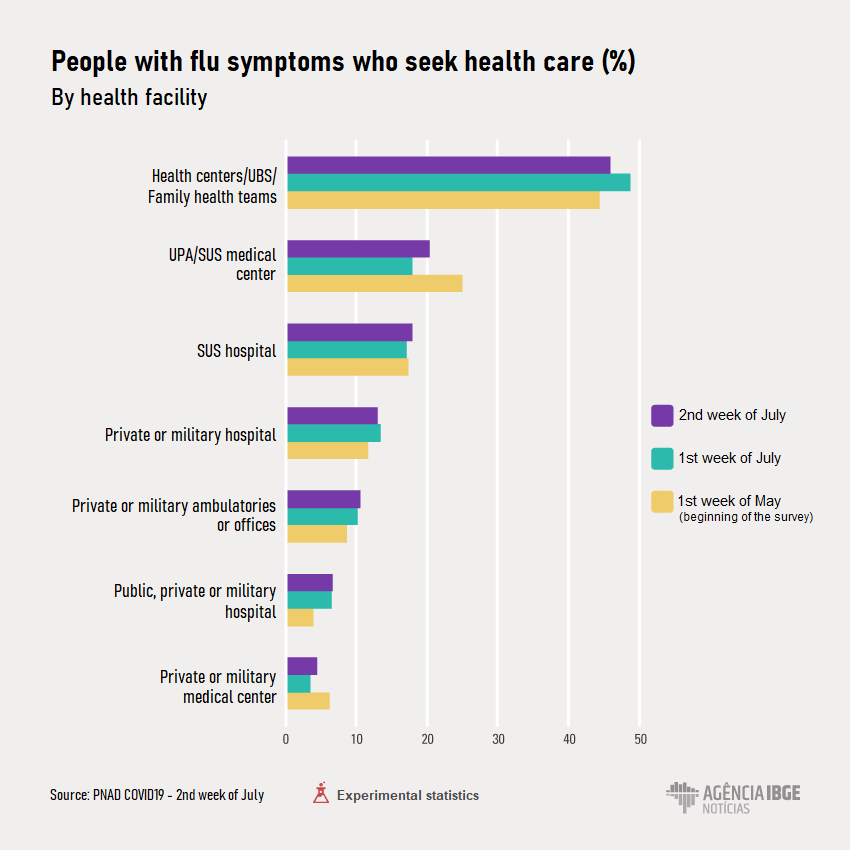PNAD COVID19
Remote work falls for the first time with relaxation of social distancing
July 31, 2020 09h00 AM | Last Updated: August 05, 2020 05h00 PM

For the first time ever, the number of employed persons who worked remotely dropped, changing from 8.9 million in the first week of July to 8.2 million in the second week. That means that nearly 700 thousand persons could have returned to work on-site with the relaxation of social distancing measures. The data are from the weekly edition of PNAD COVID19, released today (31) by the IBGE.
"This is the first significant drop in that group since the beginning of May, when the survey started. The reduction was registered both in absolute figures (643 thousand) and percentage (11.6%) and reflects what we are already seeing, which is the return of part of those persons to their offices before the pandemic," said Maria Lúcia Vieira, coordinator of the survey.
In the second week of July, the group of persons that was temporarily away from work due to social distancing remained dropping, 1.2 million less in the comparison with the previous week (8.2 million). On the other hand, persons who alleged reasons other than social distancing to be away from work increased by 623 thousand, adding up to 3.1 million.
"Social distancing has been no longer a reason to be away from work. They are alleging other reasons, like, for example, sick leave and maternity leave. That group could include persons who could have been laid off," analyzes Vieira, adding that nearly 10.1 million persons were away from work in the second week of July. They were 20 million in the beginning of May.
Number of persons who did not search for a job due to the pandemic reaches 19.2 million
The survey also shows that the number of persons who would like to work, but did not search for a job due to the pandemic or lack of jobs in the locality where they live remained stable (19.2 million). After dropping in June (17.3 million), that group returned to the level of the beginning of May (19.1 million).
As a result, the unemployment rate stayed at 13.1% in the second week of July, which corresponds to 12.2 million persons without a job. Employment also changed slightly in the same week compared with the previous one, adding up to 81.1 million persons. Yet, this figure is lower than that of the first week of May (83.9 million). Less than half of the population (47.6%) was working in the second week of July.
The informality rate stayed at 34.0%, reaching 27.6 million persons. They were 29.9 million in the beginning of May.
The informal workers are those employed in the private sector without a formal contract; domestic workers without a formal contract; employers who do not contribute to the INSS; self-employed workers who do not contribute to the INSS; and unpaid workers helping residents or relatives.
Three million persons with symptoms looked for medical care
PNAD COVID19 also unveils that of the 13.9 million persons who complained of any symptom of flu syndrome, nearly 3.0 million looked for medical care in the second week of July. These data remained stable in the comparison with the previous week, though they are lower than those registered in the beginning of May (26.8 million and 3.7 million, respectively).
Headache was the most recurrent symptom (6.3 million), followed by stuffy or runny nose (5.1 million), cough (4.4 million), muscle pain (3.6 million), sore throat (3.5 million), fatigue (2.4 million), loss of smell or taste (1.7 million), difficulty to breathe (1.7 million) and eye pain (1.5 million).
Among nearly 3.0 million persons who had any of those symptoms and looked for care, 45.9% reported to have looked for medical care in public health centers, 20.3% in medical centers and 17.9% in SUS hospitals. In the private network, 10.6% looked for either private or military ambulatories or offices, 4.4% went to private medical centers and 13%, to private hospitals.
Altogether, 914 thousand looked for care in public, private or military hospitals and 124 thousand were hospitalized.

Among the persons who had any symptom, 78.8% did not look for any health establishment in the second week of July. In contrast, 57.4% took medicines on their own. Another 13.4% took medicines under medical orientation. In addition, 4.6% called a health professional and 2.3% were visited by a health professional from SUS.
Carried out with the support of the Ministry of Health, PNAD COVID19 is a version of the National Household Sample Survey - Continuous PNAD aimed at pinpointing the impacts of the pandemic on the labor market and at quantifying the persons with symptoms associated to the flu syndrome. The IBGE releases the survey on a weekly and monthly basis. It comprises the products of the Experimental Statistics.




















